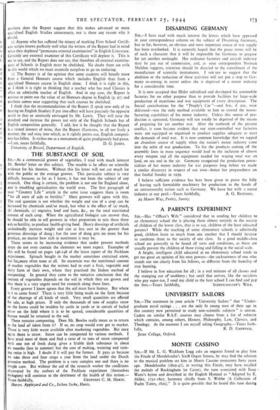THE SUBSTANCE OF SOIL SIR, —As a commercial grower of vegetables,
I read with much interest Mr. Bowles' letter on this subject. The trouble is he offers no scientific evidence for his theories. Without this his letter will not cut much ice with the public or the average grower. This particular subject is very difficult, because, as far as I know, it has not been the subject of any research. One thing is certain, the problem is not one for England alone, and is troubling agriculturists the world over. The first paragraph of your " Country Life " article in the same issue suggests there is room "for all sorts of aids to fertility." Most growers will agree with this. The real question is not whether the weight and size of a crop can be increased by chemicals and/or muck, but what is the effect of (a) muck, (b) chemicals, (c) organics, hoof and horn, &c., on the total nutritional content of each crop. When the agricultural biologist can answer that, he should be able to tell growers in what proportion to mix these three aids to fertility, to produce health-giving food. Heavy dressings of artificials undoubtedly increase weight and size at less cost to the grower than generous dressings of dung ; but the user of dung gets no more for his produce, no matter how rich in nutriment it may be.
There seems to be increasing evidence that under present methods crops do not even contain the elements we most expect. Examples of this will be found on pages 146-148 of the latest report of the Peckham experiment. Spinach bought in the market sometimes contained enow, but far.more often none at all. So uncertain was the nutritional content of market vegetables that the writers had to start a fruit, vegetable and dairy farm of their own, where they practised the Indore method of composting. In general they came to the tentative conclusion that the content of vegetables depends on the soil in which they are grown and that there is a very urgent need for research along these lines.
Every grower I know agrees that the soil must have humus. But where is it to come from? There is very little being made on the farm because of the shortage of all kinds of stock. Very small quantities are offered for sale, at high prices. If only the thousands of tons of surplus straw on the farms could be trodden by cattle in yards or in corrals of bailed straw on the field where it is to be spread, considerable quantities of humus would be returned to the soil.
There remains composting. Does Mr. Bowles really mean us to return to the land all taken from it? If so, no crop would ever get to market. There is very little waste available after marketing vegetables. But once spin there is straw. Straw can be composted by various methods. I have tried most of them and find a ratio of to tons of straw composted with one ton of fresh dung gives a friable dark substance in about six months (less in summer) but the cost of making, watering and turn- ing twice is high. I doubt if it will pay the farmer. It pays us becautie We take three and four crops a year from the land under the Dutch intensive method. The problem is a very complex one and there is no Pimple cure. But without the aid of the research worker the conditions discovered by the authors of the Peckham experiment (themselves biologists) will continue to the detriment of the health of this nation.—


























 Previous page
Previous page